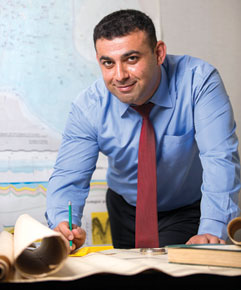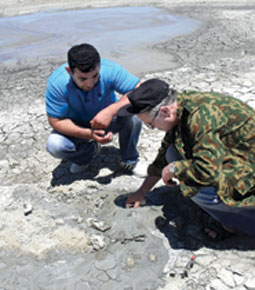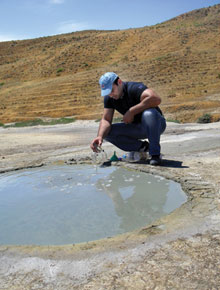An interview with Dr Orkhan Abbasov
Azerbaijan is the birthplace of some outstanding scholars and scientists, such as Nobel Prize winning physicist Lev Landau and the ‘father of fuzzy logic’, Lotfi Zadeh. Science is not being neglected in independent Azerbaijan either, with investment under way in the Academy of Sciences and the country’s universities. To find out more about the exciting developments in Azerbaijani research, Visions is holding a series of conversations with some of the country’s best young scientists. Anne Thompson-Ahmadova gets the ball rolling by interviewing geologist, Dr Orkhan Abbasov, a specialist in oil shale and mud volcanoes at the Institute of Geology.
How did you become a geologist? Was it a childhood dream?
No, it was chance! I wanted to be an oilman so after completing school in Astara I went to study at the Oil Academy. When I was there I became really interested in geology. I had always thought of a geologist as a lone scientist with a hammer going up a mountain. It’s not really like that, but it is a very romantic occupation and mud volcanoes, they are romantic too!
Could you outline your career path?
I entered the Oil Academy in 1998 and graduated in Geological Exploration in 2002 with top marks. I then began a two-year Master’s Degree in Oil Geology. I completed my Master’s in 2004 and knew then that I wanted to devote my life to science.
I joined the Academy of Sciences, as this is the best scientific institution in Azerbaijan. My first position was as a scientific researcher and translator in the Mud Volcanism Department of the Institute of Geology, as it was known at the time – it has since been renamed the Institute of Geology and Geophysics. I translated scientific papers on mud volcanism into Azerbaijani. At the same time I studied for my PhD.
I love visiting the mud volcanoes and have often wondered if they have anything to do with Azerbaijan’s oil and gas reserves.
They do! Mud volcanoes are a good indicator of the presence of oil and gas. Gas pressure is the main cause of an eruption and volcanic eruptions help to determine the location of oil.
A mud volcano is a natural exploration well, seven to eight, even 10 kilometres deep. Geologists need to know the type of rock, the geochemical analysis, characteristics and source rock of a potential well and can study all this through mud volcanoes.
Azerbaijan has not yet searched for oil and gas in deep deposits. Now we are investigating ultra-deep depositions on the basis of the products of mud volcanoes. People used to think it a waste of time to search for oil near mud volcanoes, as the volcanoes are corrupt oil fields. However, Azerbaijani geologists showed that this is not the case and in 1933 Well No. 45 at Lokbatan mud volcano began to produce oil and gas. It is still in operation, producing 20 tonnes of oil daily.
Are mud volcanoes found only in Azerbaijan?
Here at the Mud Volcanism Department we have been working on an atlas of mud volcanoes worldwide. The atlas should be published in Italy later this year. It’s taken us five years of research and we’ve found out a lot of new data. For example, we used to think that there were around 1,000 mud volcanoes worldwide but it turns out there are 2,500. And we used to think that only 25 countries had mud volcanoes but actually 42 do.
Four hundred of the world’s mud volcanoes are in Azerbaijan, in the east of the country and in the sea. So, Azerbaijan can be called the Land of Mud Volcanoes. It has all types of volcano – on land, under sea, erupted and dormant.
One of the world’s biggest mud volcanoes, Turaghay, is in Azerbaijan. It is 400 metres high. The mud volcano known to have erupted the most frequently is at Lokbatan. It has erupted 24 times, most recently in September 2012. Seismic activity within 20 kilometres of a mud volcano can make a volcano active. If various elements increase in the fluid of the volcano, this can be a sign of an impending earthquake. While eruptions are the most striking mud volcano activity, gas and water are almost constantly bubbling up from the depths and trickling down the conical-type of mud volcanoes known as gryphons.
How often do you visit the mud volcanoes?
We monitor the mud volcanoes every summer and when earthquakes occur. If we are working on special projects, then we monitor them regularly.
We have a joint project under way with Ukraine to study mud volcanoes on Crimea’s Kerch Peninsula. We made a field trip there for a week last year and were due to go again this year, but unfortunately the political situation has interfered with our plans. My colleague Ruslan Akhundov and I wrote a paper on the first stage of our research, a Comparative Analysis of Mud Volcanoes of Azerbaijan and Ukraine, based on the examples of the Qobustan region and Kerch Peninsula. We presented it at a conference in November last year on Fundamental and Applied Geological Science. Mud volcanoes in both Kerch and Qobustan are associated with Paleogene-Miocene sediments. However, we found no oil shale in the eruption products from the Kerch volcanoes, unlike in Qobustan where oil shale has been discovered. Another difference is that the Kerch volcanoes are not as diverse as those in Qobustan.
What was your PhD subject?
Oil shale, or to be more exact the distribution of combustible shales in Qobustan deposits. My supervisor gave me the subject and I was the very first person to research oil shale in Azerbaijan. I hope I will be remembered for it! There was no previous research for me to use as a starting point. The work took me five years – I defended my thesis successfully in 2009.
Azerbaijan is very rich in oil shale. The quality of our deposits is better than in most other countries, with the exception of Estonia and Australia. The quality depends on the organic content of the shale and in Azerbaijan it is a good proportion, around 20 per cent. In the lab we have managed to obtain gas and tar from Azerbaijani shale.
What are you working on at the moment?
Now we’re working on the next task – the prospects for shale gas in Azerbaijan. This is both a fundamental and applied investigation. At the same time I’m looking into oil shale in products from mud volcanoes.
What are the greatest achievements of Azerbaijani geology?
Well, the first oil well was drilled in Azerbaijan, in Bibiheybet, in 1846. Azerbaijani geologists also opened many wells here and in other countries too, especially throughout the former Soviet Union. And Azerbaijani geologists were the first to find and extract oil from a mud volcano, the one at Lokbatan.
What are the challenges facing geology in Azerbaijan?
Geologists should be out in the field, not tied to their desks. Transport to the field can be expensive so that’s one of the challenges.
We are keen to integrate with world science and attend conferences and seminars to keep up with the latest research in geology. We have a project with Geomar, a centre for ocean research in Kiel, Germany, to study mud volcanoes offshore and onshore.
As you can see our institute has recently been refurbished. It is good for us that a geologist, Akif Alizadeh, is president of the Academy of Sciences.
Is there any provision for young academics?
I am chairman of the Council of Young Scientists and Specialists at the Institute. Our activities are both academic and social. We organise conferences and seminars. Recently I represented our Academy at a conference for young scientists in India. I’m also adviser to the chairman of the scientists and specialists committee in the Academy, which keeps me in touch with other institutes.
Projects in the regions of Azerbaijan are a recent initiative of the Academy president. Scientists visit schools outside the capital to explain our work and encourage the children to consider science careers.
What are your hopes for the future?
I see my future in science. Next I would like to study for a doctor of science degree (in the Azerbaijani system, this is a higher doctorate than a PhD – ed.).
We wish you every success!





